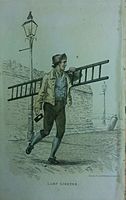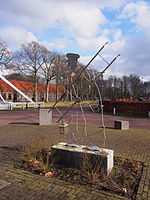Lamplighter

A lamplighter or gaslighter is a person employed to light and maintain street lights. These included candles, oil lamps, and gas lighting.
Public street lighting was developed in the 16th century.[1] During this time, lamplighters toured public streets at dusk, lighting outdoor fixtures by means of a wick on a long pole.[2] At dawn, the lamplighter would return to put them out using a small hook on the same pole. Other duties include carrying a ladder and renewing the candles, oil, or gas mantles.
In some communities, lamplighters served in a role akin to a town watchman; in others, it may have been seen as little more than a sinecure.
Beginning with Frederick Albert Winsor's 1807 exhibition at the Pall Mall,[3] gas lights steadily overtook candles and oil lamps as the dominant form of street lighting. Early gaslights required lamplighters, but by the late 19th century, systems were developed which allowed the lights to operate automatically. The advent of incandescent lighting diminished the necessity of hiring lamplighters.
As of 2009, lamplighting is a rare job.[clarification needed] However, certain cities maintain the tradition to attract tourism. These include Zagreb, Croatia;[4] Wroclaw, Poland;[5] and Brest, Belarus.[6]
Today
In Brest, Belarus, as a tourist attraction, a lamplighter has been employed since 2009 to light up the kerosene lamps in the shopping street every day.[6]
As of 2022, a small team of lamplighters still operate in London, England where gas lights have been preserved by English Heritage.[7][8]
In the European Union, there are only two cities where lamplighters are still on duty: Zagreb, Croatia[4] and Wroclaw, Poland.[5]
In Waikiki, Hawaii, lamplighters in traditional Hawaiian costumes run along the shore and light gas torches in the evening.[citation needed]
Modern outdoors usage
In the late-19th and 20th centuries, most cities with gas streetlights replaced them with new electric streetlights. For example, Baltimore, the first US city to install gas streetlights, removed nearly all of them in 1957. A gas lamp is located at N. Holliday Street and E. Baltimore Street as a monument to the first gas lamp in America, erected at that location.[9]
However, gas lighting of streets has not disappeared completely from some cities, and the few municipalities that retained gas lighting now find that it provides a pleasing nostalgic effect. Gas lighting is also seeing a resurgence in the luxury home market for those in search of historical authenticity.
The largest gas lighting network in the world is that of Berlin. With about 37,000 lamps (2014),[10] it holds more than half of all working gas street lamps in the world. In central London around 1500 gas lamps still operate, lighting the Royal Parks, the exterior of Buckingham Palace and almost the entire Covent Garden area.[citation needed] The Park Estate in Nottingham retains much of its original character, including the original gas lighting network.
In the United States, more than 2800 gas lights in Boston operate in the historic districts of Beacon Hill, Back Bay, Bay Village, Charlestown, and parts of other neighborhoods. In Cincinnati, Ohio, more than 1100 gas lights operate in areas that have been named historic districts. Gas lights also operate in parts of the famed French Quarter and outside historic homes throughout the city in New Orleans.
South Orange, New Jersey, has adopted the gaslight as the symbol of the town, and uses them on nearly all streets. Several other towns in New Jersey also retain gas lighting: Glen Ridge, Palmyra, Riverton, and some parts of Orange, Cape May, and Cherry Hill. The village of Riverside, Illinois, still uses its original gas street lights that are an original feature of the Frederick Law Olmsted planned community. Manhattan Beach, California, has a gas lamp section in which all the sidewalks are lit by public gas lamps. Disneyland has authentic 19th century gas lamps from Baltimore along the "Main Street, U.S.A." section of the theme park.
Many gas utility companies will still quote a fixed periodic rate for a customer-maintained gas lamp, and some homeowners still use such devices. However, the high cost of natural gas lighting[11] at least partly explains why a large number of older gas lamps have been converted to electricity. Solar-rechargeable battery-powered gas light controllers can be easily retrofitted into existing gas lamps to keep the lights off during daylight hours and cut energy consumption and green-house gas carbon emissions by 50%.

In culture
In 1928, Irish poet Máirtín Ó Direáin published "Fear Lasta Lampaí" ("lamp-lighting man").[12][13][14]
In 1942, American composer Hoagy Carmichael composed "Lamplighter's Serenade." It was recorded by Frank Sinatra during his first session as a solo artist, on 19 January 1942. Bing Crosby recorded a version of the song days later.
Additionally, the 1946 song "The Old Lamp-Lighter" was a pop song featuring music by Nat Simon and lyrics by Charles Tobias.
John le Carré's 1974 spy novel Tinker Tailor Soldier Spy refers to Lamplighters as a section of British Intelligence that provided surveillance and couriers.[15]
The 1975 Soviet film The Adventures of Buratino features a "Lamplighters' Song," in which a group of lamplighters perform ballet-inspired choreography while singing about their nightly duties.[16]
In 2013, NYPD whistleblower Frank Serpico, an NYPD officer, prefers to use the term "lamp-lighter" to describe the whistleblower's role as a watchman.[17]
In 2018, Jack the Lamplighter is a character in the film Mary Poppins Returns.
Gallery
- Lamplighters in art
-
Lithograph published in The World in Miniature (London, Rudolph Ackermann, 1821–25)
-
Lamplighter pubsign Stratford-upon-Avon, in England
-
Historic Howard Johnson's motel "lamplighter" sign in front of a property in Albany, New York
-
De Lantaarnopsteker by H.S. Bosma in Veenhuizen (2006)
-
Statue of a lamp-lighter (farolero) in Madrid
Further reading
- Carl Benedikt Frey. 2019. The Technology Trap: Capital, Labor, and Power in the Age of Automation. Princeton University Press.
References
- ^ Schivelbusch, Wolfgang (1987). "The Policing of Street Lighting". Yale French Studies (73): 61–74. doi:10.2307/2930197. JSTOR 2930197.
- ^ Roskell, J. S. and Clark, L. and Rawcliffe, C. (editors) BARTON, Henry (d.1435), of London. – History of Parliament Online Archived 16 August 2014 at the Wayback Machine, The History of Parliament: the House of Commons 1386–1421. ISBN 9780862999438. 1993.
- ^ 'Pall Mall, South Side, Past Buildings: Nos 93-95 Pall Mall, F.A. Winsor and the development of gas lighting', in Survey of London: Volumes 29 and 30, St James Westminster, Part 1, ed. F H W Sheppard (London, 1960), pp. 352-354. British History Online http://www.british-history.ac.uk/survey-london/vols29-30/pt1/pp352-354 [accessed 10 August 2023].
- ^ a b "Meet the Lamplighters of Zagreb Upper Town". LoveZagreb.hr. 24 August 2021.
- ^ a b "The 10 most important things to see in Wroclaw". WroclawGuide.com. 24 August 2021.
- ^ a b Юрий Рубашевский. (29 July 2009). Тепло и свет "живого" фонаря (in Russian). Vecherniy Brest. Archived from the original on 26 April 2012. Retrieved 22 December 2011.
- ^ "Carrying the Torch for London's Last Gas Lamps". NPR.org.
- ^ "We've listened: council to retain 174 heritage gas lamps following consultation". City of Westminster. 22 November 2022.
- ^ Rasmussen, Frederick (10 October 1998). "City's gaslight glow dimmed in 1957 Progress: The American gas industry was born in Baltimore in 1816, when an artist wanted a clean, smoke-free way to illuminate a roomful of paintings". Baltimore Sun. Retrieved 22 June 2013.
- ^ "Berlins Gaslight Culture association". Retrieved 6 March 2016.
- ^ Cambre, Author Aren (30 October 2005). "Gas Lamps are Expensive".
{{cite web}}:|first=has generic name (help) - ^ "FEAR LASTA LAMPAI - THE LAMPLIGHTER A WELL KNOWN IRISH POEM [THIS PLAQUE IS LOCATED IN SALTHILL]". THE STREETS OF GALWAY.
- ^ Manager, Site (8 October 2016). "Poems by Máirtín Ó Direáin". Colaiste O'Direain.
- ^ "A poem by Máirtín Ó Direáin". www.allaboutirish.ie.
- ^ "The secret codes of John le Carré's Tinker Tailor Soldier Spy". Telegraph.co.uk. 15 September 2011.
- ^ Песня фонарщиков из фильма Буратино, retrieved 10 October 2023
- ^ "'To whistleblow is like a death sentence': five people who risked". The Independent. 23 March 2013.
External links
 Media related to Lamplighters at Wikimedia Commons
Media related to Lamplighters at Wikimedia Commons





